Wyjątkowy i unikatowy na skalę światową symbol upływu czasu i przemijania...
Wirtualny spacer po Tempus Fugit: https://czasucieka.wkraj.pl
W dniu 20 września 2024 r., na terenie Cmentarza Komunalnego Podgórki Tynieckie w Krakowie odsłonięty został unikatowy na skalę światową pomnik upływu czasu i przemijania "TEMPUS FUGIT".
Podstawą dla tego pomnika jest przebiegająca przez cmentarz linia równoleżnika 50° N, wytyczona przez krakowskiego geodetę Mariusza Meusa. Wykorzystując zjawisko dryfu kontynentu ukazana jest skala ludzkiego życia w perspektywie setek i tysięcy lat - wieczności.
Pomnik powstał z okazji Międzynarodowej Konwencji Światowej Federacji Organizacji i Firm Pogrzebowych FIAT-IFTA w Krakowie (18-20 września 2024).
Cmentarz Komunalny Podgórki Tynieckie w Krakowie jest wyjątkowy ze względu na swoją lokalizację. Otaczają go piękne Lasy Tynieckie, będące częścią Bielańsko-Tynieckiego Parku Krajobrazowego, a przez teren nekropolii przebiega równoleżnik 50° N! Naszą uwagę na tę znaczącą linię współrzędnych geograficznych już jakiś czas temu zwrócił geodeta Pan Mariusz Meus (znany jako Pan Południk). Równoleżnik 50° N jest doskonale widoczny na większości map i globusów, a wraz z krzyżującym się z nim południkiem 20° E w Kosocicach pozwala na łatwe odnalezienie Krakowa w wielkim świecie. Równoleżnik ten łączy Kraków z kilkoma, znaczącymi miastami leżącymi na jego przebiegu: w Polsce są to Wodzisław Śląski, Tarnów i Rzeszów, a na świecie choćby Charków w Ukrainie, Winnipeg w Kanadzie, Moguncja w Niemczech i Praga w Czechach.
W oparciu o przebieg równoleżnika 50° N na Cmentarzu Komunalnym Podgórki Tynieckie powstał niezwykły pomnik upływu czasu i przemijania - oś czasu "TEMPUS FUGIT". Jest to unikatowy na skalę światową projekt, łączący symbolikę miejsca z nieoczywistym dla niego obiektem geodezyjnym, jakim jest równoleżnik. W dodatku, pomnik ten posiada dodatkowy, niezwykły walor edukacyjny, dzięki zastosowaniu niezwykłego zjawiska geologicznego - dryfu kontynentów. Linia równoleżnika wpisana w kontekst miejsca stała się symbolem przemijania, ukazującym długość ludzkiego życia w perspektywie setek i tysięcy lat. Jest to jedyny tego typu projekt w Polsce, pierwsze oznaczenie równoleżnika 50° N w Krakowie i pierwsze oznaczenie linii współrzędnych geograficznych na terenie jakiejkolwiek nekropolii na świecie! Drugi taki obiekt, o podobnej formie - linia równoleżnika 52° N z siedmioma jego historycznymi pozycjami - istnieje jedynie na kampusie Uniwersytetu Technicznego w mieście Delft w Holandii.
Projekt "TEMPUS FUGIT" symbolicznie pokazuje skalę długości ludzkiego życia w kontekście historycznej skali upływu czasu; wieczności. A czyni to wskazując położenie równoleżnika 50° N na przestrzeni setek i tysięcy lat, w momentach wielu ważnych wydarzeń dziejowych. Ale jak to możliwe, że równoleżnik zmienia swoje położenie? Dzieje się tak za sprawą geologicznego zjawiska dryfu kontynentów: powolnego ruchu płyt tektonicznych, powodującego wędrówkę kontynentów względem globalnej siatki współrzędnych geodezyjnych (układu odniesień ITRF). Teren Cmentarza Komunalnego Podgórki Tynieckie przemieszcza się co roku o 2,65 cm w kierunku północno-wschodnim, na azymucie 54,3°. Tym samym, linia równoleżnika 50° N w układzie globalnym ITRF - domyślnie stała, nie związana fizycznie z powierzchnią Ziemi - w efekcie wędrówki kontynentu europejskiego, a wraz z nim Polski i Krakowa, względem terenu pozornie "cofa się" na południe o 1,55 cm rocznie: tyle wynosi składowa północ-południe wektora dryfu kontynentu w tym miejscu na Ziemi; odpowiednio, składowa wschód-zachód wynosi 2,15 cm rocznie. Wobec tego, po 10 latach równoleżnik 50° N przebiegać będzie 15,5 cm na południe od swojej obecnej pozycji. Po 100 latach różnica wyniesie 1,55 metra; po tysiącleciu będzie to aż 15,5 metra... W ten sposób równoleżnik kreśli swoistą oś czasu na geologiczną skalę i pomnik "TEMPUS FUGIT" ukazuje ten wiekuisty ruch - niczym sam upływ czasu - na skalę przerastającą ludzkie pojęcie: niczym sama wieczność…
Ponieważ pomiary geodezyjne w Polsce wykonywane są w lokalnym, europejskim układzie odniesień ETRF89, dowiązanym do naszej płyty tektonicznej - aby w ten sposób zniwelować efekt dryfu kontynentu i jego wpływ na zmienność współrzędnych - wytyczony w nim przebieg równoleżnika 50° N w rzeczywistości odpowiada jego pozycji w terenie 1 stycznia 1989 roku, gdy układ europejski ETRF89 pokrywał się z globalnym układem odniesień geodezyjnych ITRF. Tym samym, aktualny (wrzesień 2024) przebieg globalnego równoleżnika 50° N w Krakowie znajduje się dokładnie 54,7 cm na południe od linii równoleżnika w obowiązującym w Polsce układzie ETRF89, w którym wykonano wytyczający go pomiar satelitarny na cmentarzu.
Przebieg równoleżnika 50° N na przestrzeni setek i tysięcy lat ukazuje jak krótkim epizodem w dziejach świata jest życie każdego człowieka. Dzięki osi czasu "TEMPUS FUGIT" można to zobaczyć na własne oczy. W okresie średniej długości życia człowieka w Polsce (według danych GUS z 2023 roku, Polacy żyją średnio 73,4 lat, zaś Polki 81,1 roku, co przeciętnie daje 77,3 roku) równoleżnik 50° N przemieszcza się o 119,4 cm! Taką też szerokość ma główny pas z ciemnego granitu, stanowiący obramowanie linii równoleżnika 50° N w układzie ETRF89. Łącznie jednak oś czasu "TEMPUS FUGIT" pokazuje aż 12 pozycji równoleżnika 50° N, w pozycjach z przeszłości, teraźniejszości ale i z przyszłości. Oto i historyczne pozycje przebiegu równoleżnika 50° N zaznaczone na Cmentarzu Komunalnym w Podgórkach Tynieckich w Krakowie.
Linia przyszłości
2240 r.
Kiedy 16 września 2240 r. kalendarz żydowski, liczący czas o biblijnego stworzenia świata, osiągnie rok 6000 (gdy nadejść ma Mesjasz aby dokonać sądu ostatecznego), równoleżnik 50° N będzie przebiegał 3 m 89 cm na południe od linii równoleżnika 50° N (ETRF89).
Linia przyszłości
2135 r.
Kiedy 7 października 2135 r. obserwowane będzie w Krakowie kolejne całkowite zaćmienie Słońca, trwające 51 sekund (poprzednie nastąpiło 26 czerwca 1424 i trwało 1 minutę 2 sekundy), równoleżnik 50° N będzie przebiegał 2 m 27 cm na południe od linii równoleżnika 50° N (ETRF89).
Linia teraźniejszości
2025 r.
W styczniu tego roku, w układzie odniesień ITRF, niezależnym od dryfu kontynentu europejskiego, równoleżnik 50° N przebiegał w tym miejscu. Co roku Kraków przemieszcza się o 2,65 cm na północny-wschód, toteż linia równoleżnika 50° N pozornie cofa się o 1,55 cm na południe. Rok za rokiem...
20 września 2024 roku, w dniu odsłonięcia pomnika Tempus fugit, linia ta leżała 55 cm na południe od od linii równoleżnika 50° N (ETRF89).
Linia przeszłości
1989 r.
Kiedy 1 stycznia 1989 r. przyjęto europejski układ odniesień ETRF89, równoleżnik 50° N w nim wyrażony zajmował to samo położenie, co w globalnej siatce współrzędnych ITRF, niezależnej od ruchu płyt tektonicznych. Od tego czasu przemieszcza się wraz z Europą...
Stalowa szyna ma szerokość 1,5 cm, dystans rocznego dryfu równoleżnika, zaś okalający szynę ciemny pas o szerokości 119,4 cm odpowiada 77,3 latom dryfu kontynentu, czyli średniej długości życia przeciętnego Polaka.
Linia przeszłości
1918 r.
Kiedy 11 listopada 1918 r. zakończyła się I wojna światowa, a po 123 latach zaborów Polska odzyskała niepodległość jako republika II Rzeczpospolitej, równoleżnik 50° N przebiegał 1 m 08 cm na północ od linii równoleżnika 50° N (ETRF89).
Linia przeszłości
1795 r.
Kiedy 24 października 1795 r. dokonano III rozbioru Królestwa Polskiego, a miesiąc później abdykował Stanisław August Poniatowski, ostatni król I Rzeczpospolitej, równoleżnik 50° N przebiegał 2 m 98 cm na północ od linii równoleżnika 50° N (ETRF89).
Linia przeszłości
1609 r.
Kiedy 24 maja 1609 r. król Zygmunt III Waza na skutek pożaru pałacu królewskiego na Wawelu, dotąd mieszkający w pałacu w Łobzowie, przeniósł dwór z Krakowa do Warszawy, równoleżnik 50° N przebiegał 5 m 86 cm na północ od linii równoleżnika 50° N (ETRF89).
Linia przeszłości
1410 r.
Kiedy 15 lipca 1410 r. połączone wojska polskie, litewskie i ruskie pokonały siły zakonu krzyżackiego podczas bitwy na polach pod Grunwaldem, równoleżnik 50° N przebiegał 8 m 94 cm na północ od linii równoleżnika 50° N (ETRF89).
Linia przeszłości
1257 r.
Kiedy 5 czerwca 1257 r. książę Bolesław Wstydliwy wydał akt lokacyjny miasta Krakowa na prawie magdeburskim, wytyczając Rynek Główny i siatkę ulic Starego Miasta, równoleżnik 50° N przebiegał 11 m 30 cm na północ od linii równoleżnika 50° N (ETRF89).
Linia przeszłości
966 r.
Kiedy 14 kwietnia 966 r. pierwszy władca Polski, Mieszko I przyjął chrzest (rok wcześniej podróżnik Ibrahim ibn Jakub po raz pierwszy wspomniał w swojej relacji o Krakowie), równoleżnik 50° N przebiegał 15 m 80 cm na północ od linii równoleżnika 50° N (ETRF89).
Linia przeszłości
476 r. n.e.
Kiedy 4 września 476 r. germański wódz Odoaker zdetronizował ostatniego cesarza Imperium Zachodniorzymskiego, 13-letniego Flawiusza Romulusa Augustusa, równoleżnik 50° N przebiegał 23 m 37 cm na północ od linii równoleżnika 50° N (ETRF89).
Linia przeszłości
5 r. p.n.e.
Kiedy (prawdopodobnie) 25 grudnia 5 r. p.n.e. w Betlejem Judzkim narodził się Jezus, syn Józefa z Nazaretu i Maryi, uznawany za mesjasza i Boga w religiach chrześcijańskich, a za proroka w Islamie, równoleżnik 50° N przebiegał 31 m 33 cm na północ od linii równoleżnika 50° N (ETRF89).
Linia przeszłości
753 r. p.n.e.
Kiedy wedle legendy, 21 kwietnia 753 r. p.n.e. Romulus zabił brata Remusa i stał się pierwszym królem założonego przez siebie miasta Rzymu, równoleżnik 50° N przebiegał 42 m 33 cm na północ od linii równoleżnika 50° N (ETRF89).
Linia przeszłości
1620 r. p.n.e.
Kiedy nastąpiła erupcja wulkanu Thira na greckiej wyspie Santorini, która doprowadziła do kryzysu kultury Minojskiej i była źródłem mitu o Atlantydzie, równoleżnik 50° N przebiegał 55 m 73 cm na północ od linii równoleżnika 50° N (ETRF89).
Linia przeszłości
2560 r. p.n.e.
Kiedy ukończono budowę wysokiej pierwotnie na 146,59 metra Wielkiej Piramidy w Gizie, jako grobowca faraona Chufu, nazywanego po grecku Cheopsem, równoleżnik 50° N przebiegał 70 m 25 cm na północ od linii równoleżnika 50° N (ETRF89).
Linia przeszłości
3761 r. p.n.e.
Kiedy 7 października 3761 r. p.n.e. rozpoczął się religijny kalendarz żydowski, liczący czas od pierwszego dnia stworzenia świata według opisu z Księgi Rodzaju w Torze oraz Biblii, równoleżnik 50° N przebiegał 88 m 84 cm na północ od linii równoleżnika 50° N (ETRF89).
Oś czasu Tempus fugit została przedłużona na przy okazji oddania nowej części cmentarza, a biegnąca tam kontynuacja alei pozwoliła na oznaczenie historycznych pozycji równoleżnika 50° N aż do 4 tysiąclecia p.n.e.; oś zamyka data 7 października 3761 r. p.n.e. czyli pierwszy dzień kalendarza żydowskiego - dzień stworzenia świata według Biblii i Tory; 88 m 84 cm na północ od głównej linii równoleżnika. W ten sposób obiekt stał się kompletny ideowo, ukazując skalę czasu w kontekście eschatologicznym: od początku świata, do jego końca - z życiem nas wszystkich i zbiorową historią ludzkości rozpiętymi pomiędzy tymi ekstremami... Jak życie człowieka rozpięte jest pomiędzy narodzinami i śmiercią...
Zapraszamy do odwiedzenia tego wyjątkowego pomnika upływu czasu i przemijania w przestrzeni Cmentarza Komunalnego Podgórki Tynieckie w Krakowie.
TRANSLATION OF TEXT INTO ENGLISH
The “TEMPUS FUGIT” – TIME IS FLETING – project
An extraordinary and unique symbol of the passage of time and transience...
The commemorative plaque at the entrance to the cemetery
On September 20, 2024, a globally unique monument to the passage of time and transience, “TEMPUS FUGIT”, will be unveiled at the Podgórki Tynieckie Municipal Cemetery in Krakow.
The basis for this monument is the line of the 50th parallel north that is running through the cemetery, marked out by the Krakow surveyor Mariusz Meus. The scale of human life is shown in the perspective of hundreds and thousands of years – eternity – taking advantage of the phenomenon of continental drift.
The monument was erected on the occasion of the International Convention of the World Federation of Funeral Organizations and Companies FIAT-IFTA in Krakow (September 18-20, 2024).
The course of the 50th parallel north through the cemetery
The Podgórki Tynieckie Municipal Cemetery in Krakow is unique due to its location. It is surrounded by the beautiful Tyniec Forests, which are a part of the Bielańsko-Tyniecki Landscape Park, and the 50th parallel north runs across the necropolis area! Our attention to this significant line of geographical coordinates was drawn some time ago by the surveyor Mr. Mariusz Meus (known as Mr. Meridian). The parallel of 50 degrees north is perfectly visible on most maps and globes, and together with the 20 degrees east meridian crossing it in Kosocice, it allows to find Krakow easily in the big world. This parallel connects Krakow with several significant cities located along its course: in Poland they include Wodzisław Śląski, Tarnów and Rzeszów, and in the world, for example, Kharkiv in Ukraine, Winnipeg in Canada, Mainz in Germany and Prague in the Czech Republic.
At the Podgórki Tynieckie Municipal Cemetery, on the basis of the course of the 50th parallel north, an unusual monument to the passage of time and transience was created – the „TEMPUS FUGIT” timeline,. It is a project unique on a global scale, combining the symbolism of the burial place with a geodetic object that is not obvious to it, which is the parallel. Moreover, the monument has an additional, extraordinary educational value, thanks to the use of an unusual geological phenomenon – the continental drift. The line of the parallel inscribed in the context of the burial place has become a symbol of transience, showing the length of human life in the perspective of hundreds and thousands of years. It is the only project of this type in Poland, the first marking of the 50th parallel north in Krakow and the first marking of geographical coordinate lines in any necropolis in the world! The second object of similar character - the line of the 52nd parallel north with seven of its historical positions – exists only on the campus of the Technical University of Delft in the Netherlands.
The “TEMPUS FUGIT” project symbolically shows the scale of human life expectancy in the context of the historical scale of the passage of time; Eternity. And it does this by indicating the location of the 50th parallel north over hundreds and thousands of years, at the moments of numerous important historical events. But how is it possible that the parallel changes its position? It occurs due to the geological phenomenon of continental drift: the slow movement of tectonic plates, causing the continents to move relative to the global grid of geodetic coordinates (ITRF reference system). The area of the Podgórki Tynieckie Municipal Cemetery moves every year by 2.65 cm in the north-eastern direction, on an azimuth of 54.3°. Thus, the line of the “TEMPUS FUGIT” – constant by default, not physically related to the Earth’s surface – as a result of the migration of the European continent, together with Poland and Krakow, seemingly „shifts back” to the south by 1.55 cm per year: this is the north-south component of the continent’s drift vector at this point on Earth; respectively, the east-west component is 2.15 cm per year. Therefore, in 10 years, the 50th parallel north will move 15.45 cm south of its current position. After 100 years, the difference will reach 1.545 meters; After the millennium, it will be as much as 15.45 meters... In this way, the parallel draws a kind of timeline of time on a geological scale, and the “TEMPUS FUGIT” timeline will show this eternal movement – like the very passage of time – on a scale beyond human comprehension: like eternity itself
Since geodetic measurements in Poland are carried out in the local, European reference system ETRF89, attached to our tectonic plate – in order to eliminate the effect of continental drift and its impact on the variability of coordinates – the course of the 50th parallel north delineated in it actually corresponds to its position in the field on January 1, 1989, when the European ETRF89 system coincided with the global ITRF geodetic reference system. Thus, the current (September 2024) course of the global 50th parallel north in Krakow is located 54.7 cm south of the parallel line in the ETRF89 system applicable in Poland, in which the satellite measurement delineating it at the cemetery was made.
The course of the 50th parallel north over hundreds and thousands of years shows how short an episode in the history of the world the life of every human being is. You can see it with your own eyes owing to the “TEMPUS FUGIT” timeline. During the average life span of a person in Poland (according to the Central Statistical Office data of 2023, Polish men live an average of 73.4 years, and Polish women 81.1 years, which gives an average of 77.3 years), the 50th parallel north moves by 119.4 cm! This is also the width of the main strip of dark granite, which is the border of the 50th parallel north in the ETRF89 system. In total, however, the “TEMPUS FUGIT” timeline shows as many as 12 positions of the 50th parallel north in the past, present and future. There are the following historical positions of the 50th parallel north marked at the Municipal Cemetery in Podgórki Tynieckie in Krakow.
The course of the 50th parallel north over hundreds and thousands of years
The line of the future
2240
When the Jewish calendar, counting the time from the biblical creation of the world, reaches the year 6000 on September 16, 2240 (when the Messiah is to come to perform the final judgment), the 50th parallel north will run 3 m 89 cm south of the main 50th parallel north line (ETRF89).
The line of the future
2135
When on October 7, 2135, another total solar eclipse, lasting 51 seconds, will be observed in Krakow (the previous one occurred on June 26, 1424 and lasted 1 minute 2 seconds), the 50th parallel north will run 2 m 27 cm south of the main 50th parallel north line (ETRF89).
The line of the present
2025
In January of this year, in the ITRF reference system, independent of the drift of the European continent, the 50th parallel north ran at this point. Every year, Krakow moves 2.65 cm to the north-east, so the parallel line seemingly moves back to the south by 1.55 cm. Year after year...
The line of the past
1989
When the European reference system ETRF89 was adopted on January 1, 1989, the 50th parallel north identified in it occupied the same position as in the global ITRF coordinate grid, independent of the movement of tectonic plates. Since that time, it has been moving together with Europe...
The steel rail is 1.5 cm wide, the distance of the annual drift of the parallel, and the dark stripe surrounding the rail with a width of 119.4 cm corresponds to 77.3 years of continental drift, i.e. the average life expectancy of an average Pole.
The line of the past
1918
When World War I ended on November 11, 1918, and after 123 years of partitions, Poland regained its independence as the Second Republic of Poland, the 50th parallel north ran 08 cm north of the main 50th parallel north line (ETRF89).
The line of the past
1795
When the Third Partition of the Kingdom of Poland was carried out on October24, 1795, and Stanisław August Poniatowski, the last king of the First Republic of Poland abdicated a month later, the 50th parallel north ran 2 m 98 cm north of the main 50th parallel north line (ETRF89).
The line of the past
1609
When on May 24, 1609, King Sigismund III Vasa, as a result of a fire in the royal palace at Wawel, residing up to that point in the palace in Łobzów, moved the court from Kraków to Warsaw, the 50th parallel north ran 5 m 86 cm north of the main 50th parallel north line (ETRF89).
The line of the past
1410
When on July 15, 1410, the combined Polish, Lithuanian and Ruthenian armies defeated the forces of the Teutonic Order during the Battle of Grunwald, the 50th parallel north ran 8 m 94 cm north of the main 50th parallel north line (ETRF89).
The line of the past
1257
When on June5, 1257, Duke Bolesław the Chaste issued the foundation act of the city of Kraków pursuant to the Magdeburg Law, delineating the Main Market Square and the grid of streets of the Old Town, the 50th parallel north ran 11 m 30 cm north of the main 50th parallel north line (ETRF89).
The line of the past
966 A.D.
When on April 14, 966, the first ruler of Poland, Mieszko I, was baptized (a year earlier, the traveler Ibrahim ibn Jakub mentioned Krakow for the first time in his account), 50th parallel north ran 15 m 80 cm north of the main 50th parallel north line (ETRF89).
The line of the past
476 A.D.
When on September 4, 476, the Germanic commander Odoacer dethroned the last emperor of the Western Roman Empire, the 13-year-old Flavius Romulus Augustus, the 50th parallel north ran 23 m 37 cm north of the main 50th parallel north line (ETRF89).
The line of the past
5 B.C.
When (probably) on December 25, 5 BCE, Jesus, the son of Joseph of Nazareth and Mary, recognized as the Messiah and God in Christian religions, and as a prophet in Islam, was born in Bethlehem of Judea, the 50th parallel north ran 31 m 33 cm north of the main 50th parallel north line (ETRF89).
The line of the past
753 B.C.
When, according to the legend, on April 21, 753 B.C., Romulus killed his brother Remus and became the first king of the city of Rome founded by him, the 50th parallel north ran 42 m 33 cm north of the main 50th parallel north line (ETRF89).
The line of the past
1620 B.C.
When the Thira volcano on the Greek island of Santorini erupted, which led to a crisis of the Minoan culture and gave rise to the myth of Atlantis, the 50th parallel north ran 55 m 73 cm north of the main 50th parallel north line (ETRF89).
The line of the past
2560 B.C.
When the originally 146.59 meters high Great Pyramid of Giza – the tomb of Pharaoh Khufu, called Cheops in Greek, was completed, the 50th parallel north ran 70 m 25 cm north of the main 50th parallel north line (ETRF89).
The line of the past
3761 B.C.
When on October 7, 3761 B.C. the Jewish religious calendar began, counting the time from the first day of the creation of the world as described in the Book of Genesis in the Torah and the Bible, the 50th parallel north ran 88 m 84 cm north of the main 50th parallel north line (ETRF89).
The Tempus fugit timeline has been extended with commissioning of a new part of the cemetery, and the continuation of the alley running there allowed for marking the historical positions of the 50th parallel north up to the 4th millennium B.C.; the axis closes with the date of October 7, 3761 B.C., i.e. the first day of the Jewish calendar – the day when according to the Bible and the Torah the world was created; 88 m 84 cm north of the main line of the parallel. In this way, the object has become ideologically complete, showing the scale of time in an eschatological context: from the beginning of the world, to its end – with the lives of all of us and the collective history of humanity extending between these extremes... Just like human life extends between birth and death...
We invite you to visit this unique monument to the passage of time and transience in the area of the Podgórki Tynieckie Municipal Cemetery in Krakow.
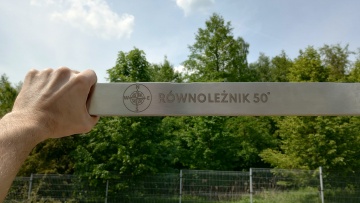

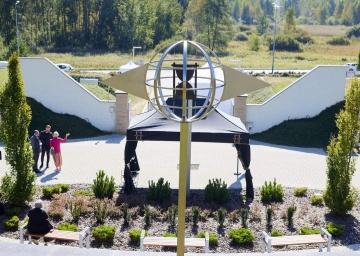
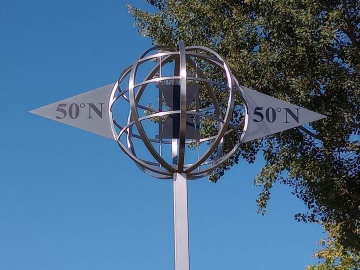
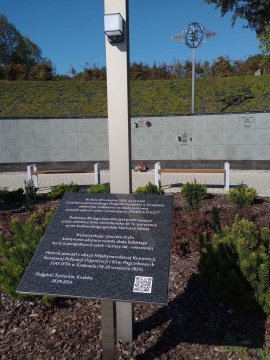
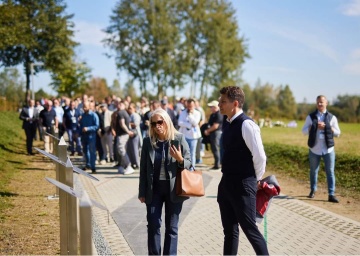
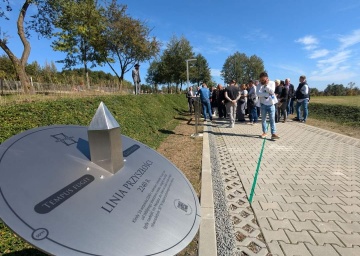
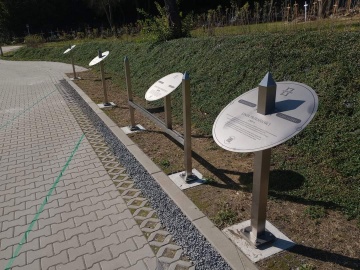
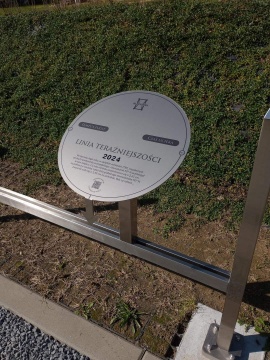
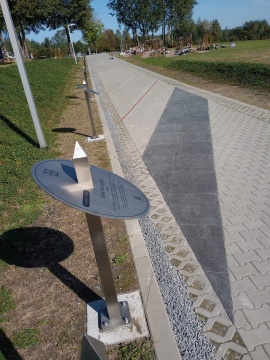
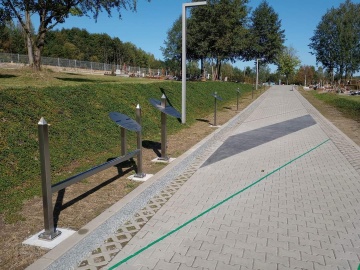
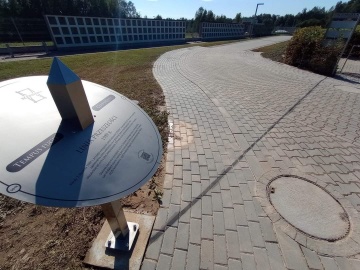
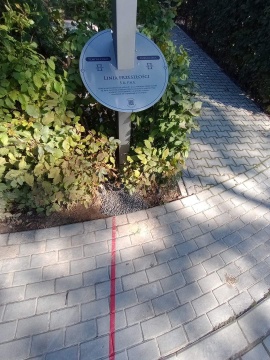
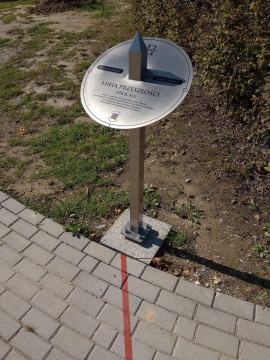
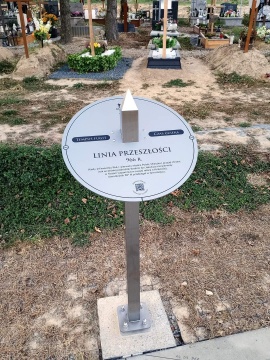
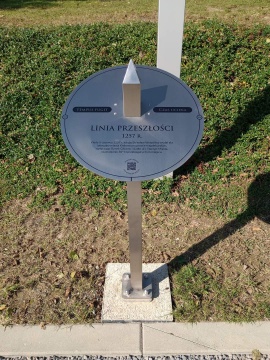
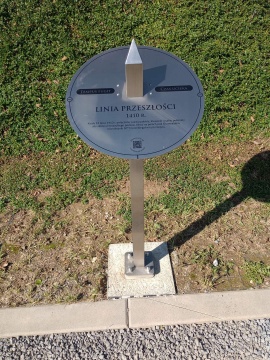
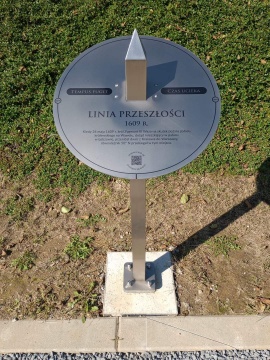
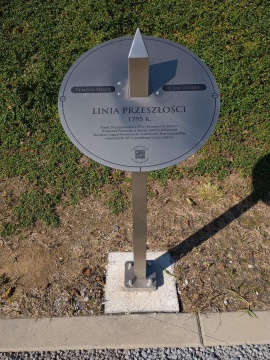
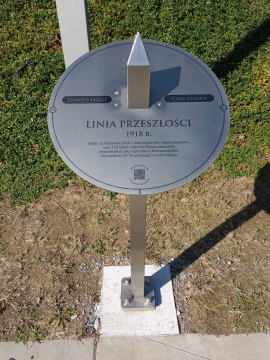
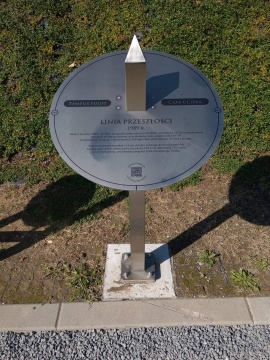
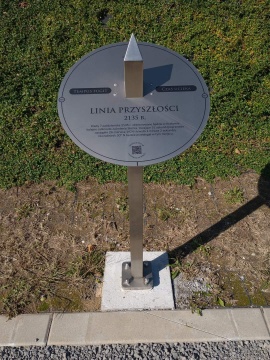
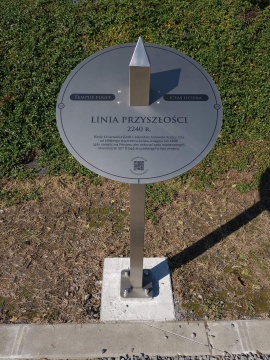
Foto: Mariusz Meus - "PAN POŁUDNIK" / Honorowy Południk Krakowski



